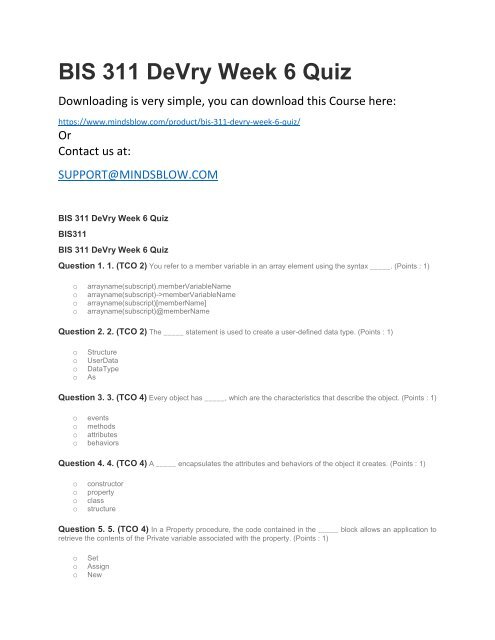BIS 311 DeVry Week 6 Quiz
Create successful ePaper yourself
Turn your PDF publications into a flip-book with our unique Google optimized e-Paper software.
<strong>BIS</strong> <strong>311</strong> <strong>DeVry</strong> <strong>Week</strong> 6 <strong>Quiz</strong><br />
Downloading is very simple, you can download this Course here:<br />
https://www.mindsblow.com/product/bis-<strong>311</strong>-devry-week-6-quiz/<br />
Or<br />
Contact us at:<br />
SUPPORT@MINDSBLOW.COM<br />
<strong>BIS</strong> <strong>311</strong> <strong>DeVry</strong> <strong>Week</strong> 6 <strong>Quiz</strong><br />
<strong>BIS</strong><strong>311</strong><br />
<strong>BIS</strong> <strong>311</strong> <strong>DeVry</strong> <strong>Week</strong> 6 <strong>Quiz</strong><br />
Question 1. 1. (TCO 2) You refer to a member variable in an array element using the syntax _____. (Points : 1)<br />
o<br />
o<br />
o<br />
o<br />
arrayname(subscript).memberVariableName<br />
arrayname(subscript)->memberVariableName<br />
arrayname(subscript)[memberName]<br />
arrayname(subscript)@memberName<br />
Question 2. 2. (TCO 2) The _____ statement is used to create a user-defined data type. (Points : 1)<br />
o<br />
o<br />
o<br />
o<br />
Structure<br />
UserData<br />
DataType<br />
As<br />
Question 3. 3. (TCO 4) Every object has _____, which are the characteristics that describe the object. (Points : 1)<br />
o<br />
o<br />
o<br />
o<br />
events<br />
methods<br />
attributes<br />
behaviors<br />
Question 4. 4. (TCO 4) A _____ encapsulates the attributes and behaviors of the object it creates. (Points : 1)<br />
o<br />
o<br />
o<br />
o<br />
constructor<br />
property<br />
class<br />
structure<br />
Question 5. 5. (TCO 4) In a Property procedure, the code contained in the _____ block allows an application to<br />
retrieve the contents of the Private variable associated with the property. (Points : 1)<br />
o<br />
o<br />
o<br />
Set<br />
Assign<br />
New
o<br />
Get<br />
Question 6. 6. (TCO 4) The code in the _____ allows an application to assign a value to the Private variable<br />
associated with the property. (Points : 1)<br />
o<br />
o<br />
o<br />
o<br />
get block<br />
default constructor<br />
set block<br />
Property procedure<br />
Question 7. 7. (TCO 4) A Property procedure begins with the keywords _____. (Points : 1)<br />
o<br />
o<br />
o<br />
o<br />
Public [ReadOnly | WriteOnly] Property<br />
Private [ReadOnly | WriteOnly] Property<br />
Start [ReadOnly | WriteOnly] Property<br />
Dim [ReadOnly | WriteOnly] Property<br />
Question 8. 8. (TCO 2) A constructor that has no parameters is called the _____. (Points : 1)<br />
o<br />
o<br />
o<br />
o<br />
Property procedure<br />
default constructor<br />
parameterized constructor<br />
set block<br />
Question 9. 9. (TCO 2) When two or more methods have the same name but different parameters, the methods<br />
are referred to as _____. (Points : 1)<br />
o<br />
o<br />
o<br />
o<br />
default methods<br />
parameterized methods<br />
overloaded methods<br />
property procedures<br />
Question 10. 10. (TCO 3) Which of the following declares a class-level, Employee-structure variable named<br />
salaried? (Points : 1)<br />
o<br />
o<br />
o<br />
o<br />
Private salaried As Employee<br />
Private Employee as Salaried<br />
Dim Employee As Hourly<br />
Dim hourly As Employee<br />
Question 11. 11. (TCO 3) Although it is not a requirement, the convention is to use _____ for the class name.<br />
(Points : 1)<br />
o<br />
o<br />
o<br />
o<br />
camel case<br />
verbs<br />
Pascal case<br />
upper case<br />
Question 12. 12. (TCO 3) The _____ indicates that the property's value can be retrieved by an application, but the<br />
application cannot set the property. (Points : 1)<br />
o<br />
o<br />
o<br />
o<br />
ReadOnly keyword<br />
WriteOnly keyword<br />
ReadWrite keyword<br />
ReadNotWrite keyword
Question 13. 13. (TCO 3) You enter the inherits clause _____ the derived class to inherit. (Points : 1)<br />
o<br />
o<br />
o<br />
o<br />
immediately above<br />
on the same line as<br />
in a separate sub procedure from<br />
immediately below<br />
Question 14. 14. (TCO 7) The _____ keyword is used to define a derived class from a base class. (Points : 1)<br />
o<br />
o<br />
o<br />
o<br />
Instantiates<br />
Inherits<br />
Derives<br />
Uses<br />
Question 15. 15. (TCO 7) The _____ keyword is used to refer to the base class in a derived class. (Points : 1)<br />
o<br />
o<br />
o<br />
o<br />
Base<br />
MyBase<br />
Super<br />
Parent<br />
Question 16. 16. (TCO 2) Most programmers use the _____ statement instead of the Structure statement to create<br />
data types that contain procedures. (Points : 1)<br />
o<br />
o<br />
o<br />
o<br />
Class<br />
Dim<br />
Object<br />
Block<br />
Question 17. 17. (TCO 2) In OOP terminology, each _____ is referred to as an instance of a class. (Points : 1)<br />
o<br />
o<br />
o<br />
o<br />
property<br />
object<br />
method<br />
attribute<br />
Question 18. 18. (TCO 2) The behaviors of an object include its methods and _____. (Points : 1)<br />
o<br />
o<br />
o<br />
o<br />
events<br />
properties<br />
attributes<br />
classes<br />
Question 19. 19. (TCO 4) A programmer uses a _____ statement to define a class. (Points : 1)<br />
o<br />
o<br />
o<br />
o<br />
Class<br />
Structure<br />
Object<br />
New<br />
Question 20. 20. (TCO 4) A class's _____ variables are not visible to applications that contain an instance of the<br />
class. (Points : 1)<br />
o<br />
o<br />
Public<br />
Private
o<br />
o<br />
Private and Public<br />
Static

















